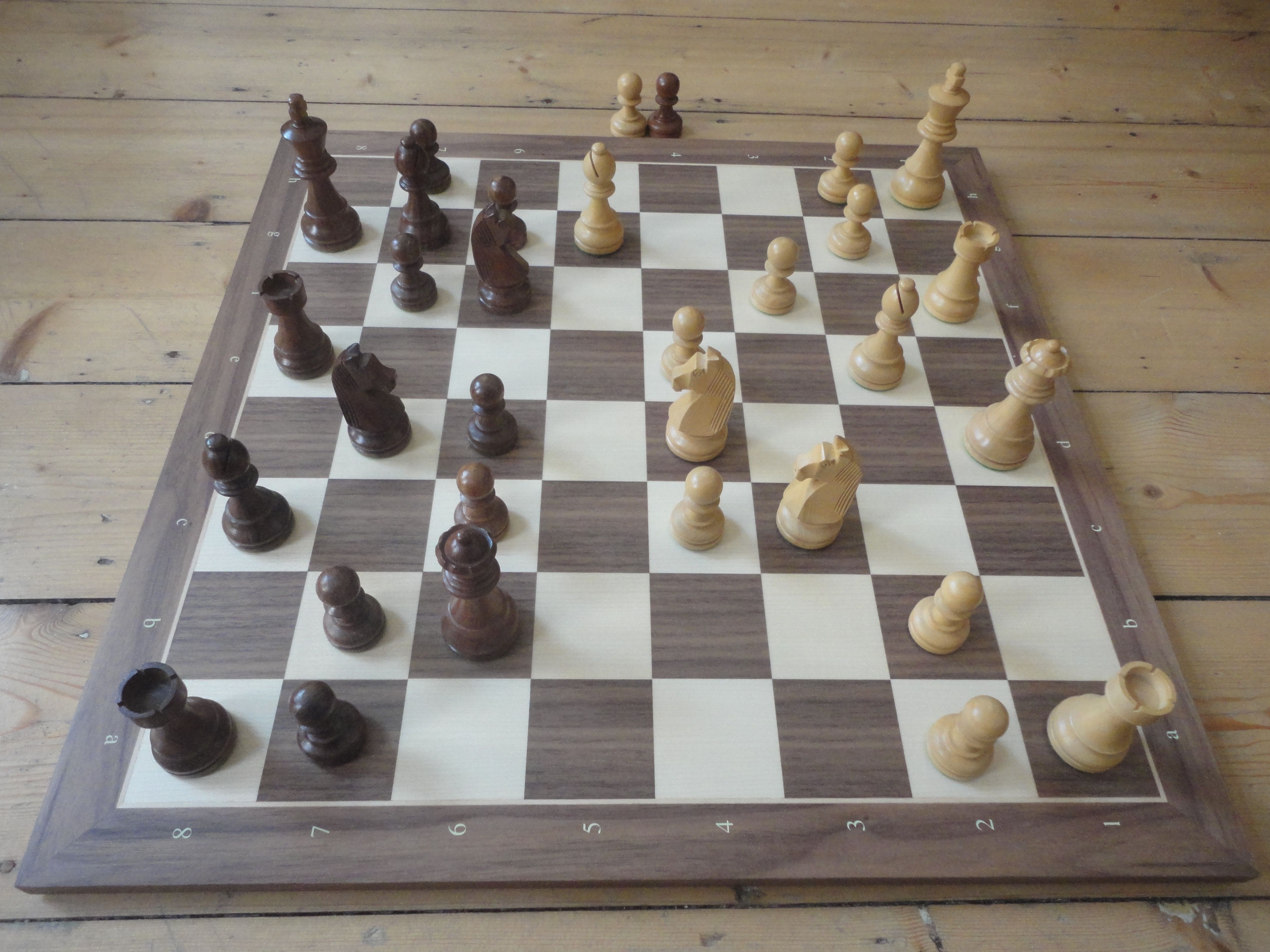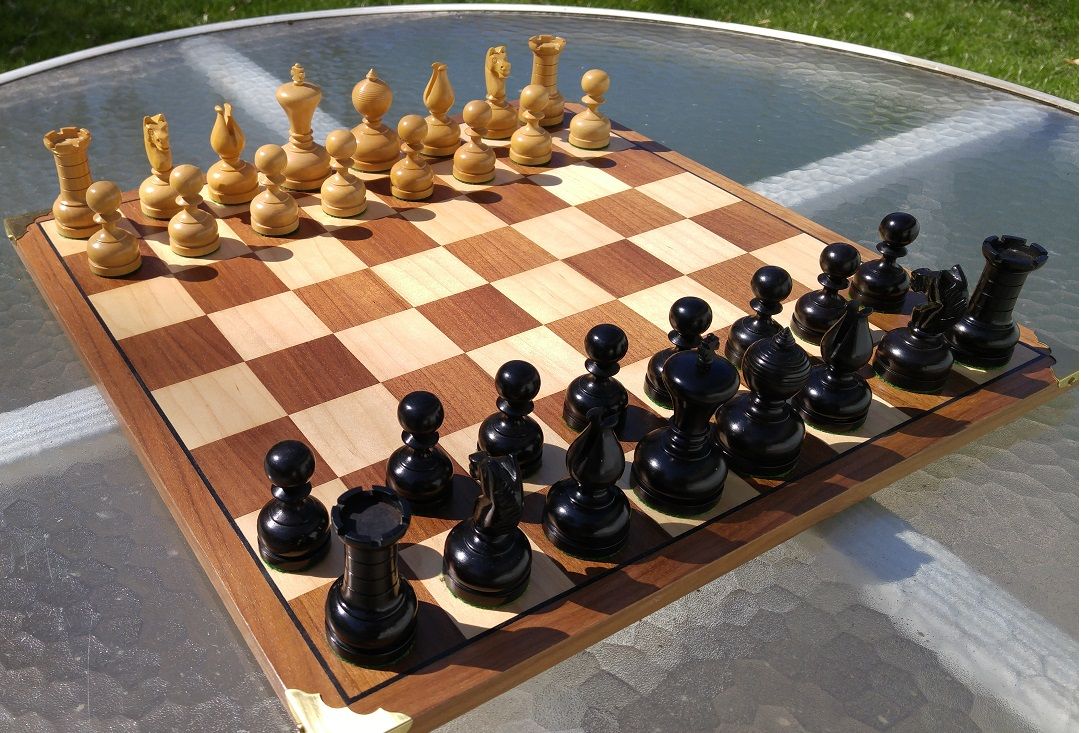Since I think you play in OTB tourneys, I would use exactly what they use in the tourneys in which you play. It's probably not critical, though.
How do sets compare for play and analysis?
Well, I'm not looking for personal advice but I am interested in the general question of which sets work better for analysis.
A nice chess set is a thing of beauty and a joy forever, but if you were to use it for the hard work of chess -- analyzing positions -- are some better than others and why?
House of Staunton has some beautiful sets costing hundreds and even thousands of dollars, but many of those would be useless to me for analysis because I would get caught up in the knight's rippling mane or some other details.
I'm taking another bash at the Yusupov training course which demands the student do everything over a physical chess set and never a computer.
I'm not sure why Yusupov is such a stickler on this point other than blocking the temptation to let the computer do the thinking.
Interesting post.
Personally for me the difference between a playing- and analysing set is not so important. The idea that "works" for me is that in the major tournaments with top players the electronic DGT - Timeless set is default. So I'm convinced it will just be fine for me also. I don't need to broadcast my games so the non-electronic set will do the job. You can buy these sets at HOS, CB, DGT-shop etc. They're not that expensive and easy to find so replacement is rarely an issue.

I've to admit altought that for analysing and to play blitz games I do like the Dubrovnik Zagreb plastic ( http://chessgamesshop.com/index.php?c=13&p=933 ). The set has a nice weight by his own (not weighted) and feel. The pieces are broad and very stable and fit perfectly on a 20" board.

I generally prefer a computer because it keeps track of positions and variations far better than I do, and can do some things I can't. Say, for example, I want to replay games of a particular opening variation. I can find all of the grandmaster games that start from the tabiya position and have the computer play through them. And if I play through the games and positions in a book, I can keep them in a database for later study and review. I could go on but you're not asking about the use of software and databases, and I'm talking about how the ability to use them for analysis draws me there and away from a physical board.
Sometimes I do like to use a physical board. When I do, if I'm not going for a particular aesthetic, like using a Soviet GM set to replay Tal games, I prefer small boards and pieces because it's easier for me to take the board in all at once. 3" kings are better for me than 4.4" ones.
In this topic by "analysis" I mean the act of looking at a physical chess set while formulating the best move for the displayed position.
Some sets are better than others for that task. As Cgrau points out, a 4.4" king makes it harder to take in the whole board. For some people a 3" king might be too small. A 3.75" king is in the Goldilocks zone of being just right for an average-size adult, though perhaps not for a six year-old child.
Speaking for myself, I don't want a lot of distracting detail on chess pieces like a wind-rippled mane on the knight or a filigreed cross on the king. There is something to be said for the Dubrovnik which replaced the cross with a simple sphere, though the original intent was to remove religious references from the set.
Needless to say, I'm not keen on theme sets styled like the American Revolutionary War or beach bikini beauties either!
I think chess sets can be beautiful and I understand the desire to collect them. I've got no bone to pick there.
However, I do wonder how much people use their sets for play or analysis and which sets they prefer for that and why.
For me it depends where I am at the time.
When I want to analyze in our family room, I use our long, rectangular ottoman and I prefer a 2.0" folding board, mahogany and maple, with the Taj Mahal set from The Rochester Chess Center, in Rosewood. The pieces are simple enough to not distract me from the game and analysis.
Taj Mahal Set in Rosewood:

When I am at our local Panera Bread Company, or another restaurant with similar sized tables and want to analyze on a bigger set I have recently gone to and now regularly use the Ultimate Chess Set in Rosewood from, once again, The Rochester Chess Center. Of course if I might be in a more chaotic environment, I will pull out my plastic Ultimate Chess Set from Dewain when he owned American Chess Equipment.
Ultimate Set in Rosewood:

My nicer sets; Dubrovnik, HoS Fischer Spassky, HoS Players Series, Mechanics Institute, and so on I only play rated games with.
Interestingly enough, Bobby Fischer analyzed on what we now call a Dubrovnik II design. And I know I could use my Noj Dubrovnik sets for analysis, but I am not too prone to use my sets costing over $450 for analysis.
And if I want a smaller footprint then I have gone to a 1.75" folding linen board that HoS had on clearance with either a plastic HoS Marshall Series Analysis set in Natural instead of Ivory, or a small set that The Rochester Chess Center calls their 3.25", 035, European Knight Sheesham Set. Both sets work very well on that folding board with a small footprint while keeping the feel of a real chess set for me.
Rochester Chess Center 035, 3.25" set in Sheesham:

In this topic by "analysis" I mean the act of looking at a physical chess set while formulating the best move for the displayed position.
Some sets are better than others for that task. As Cgrau points out, a 4.4" king makes it harder to take in the whole board. For some people a 3" king might be too small. A 3.75" king is in the Goldilocks zone of being just right for an average-size adult, though perhaps not for a six year-old child.
Speaking for myself, I don't want a lot of distracting detail on chess pieces like a wind-rippled mane on the knight or a filigreed cross on the king. There is something to be said for the Dubrovnik which replaced the cross with a simple sphere, though the original intent was to remove religious references from the set.
Needless to say, I'm not keen on theme sets styled like the American Revolutionary War or beach bikini beauties either!
Here's what I'm currently using to go through William Lomabrdy's latest book. It's a 3" Lardy on a roll-up French board. It's small. I can digest what I see. It's light. I can move it to just about wherever I want to sit. And it puts to use equipment I'd never use for a "real" game.


I'm fairly confident I didn't give you personal advice, but rather advice on what kind of chess set to use for analysis. Personal advice would be to go for some beach bikini beauties instead of reading these forums. Maybe I should take my own advice.
Cgrau: Interesting thought to use a 3" set.
A few weeks ago I went to a cafe with a tournament chess set and a chess book. Turns out you can't fit a sandwich and a beverage on a cafe table when it's covered with a 2.25" squares rollup board.
@whomever:
There are some nice sets of varying sizes at the following site. They range from Fischer's wallet chess set (featured in the film Pawn Sacrifice) to real wooden pieces and boards.
http://www.chessmate.com/chessmate1.html
I prefer having two boards side-by-side when studying -- one for the mainline and one for sidelines. Obviously, the boards will have to be small to fit on a cafe table. You may have to eat your sandwich first.
Cgrau: Interesting thought to use a 3" set.
A few weeks ago I went to a cafe with a tournament chess set and a chess book. Turns out you can't fit a sandwich and a beverage on a cafe table when it's covered with a 2.25" squares rollup board.
Truth be told, I'd play with the smaller sets I've collected for their design or historical character only under unusual circumtances. So in addition to the compact visual field, this is one way to press my smaller sets into service.
So it would seem there is not much to say about how different sets compare when it comes to the standard scenario of a player staring intently at a position while considering its possibilities.
So it would seem there is not much to say about how different sets compare when it comes to the standard scenario of a player staring intently at a position while considering its possibilities.
That's a broader question, as it would encompass over the board play as well. I'm afraid I've said about as much as I can about studying as I do most of mine in front of a computer screen. When I deviate, I like the smaller sets, and they must be recognizably Staunton. I include Dubros and the Soviet sets I've posted elsewhere in that. I wouldn't use a pre-Staunton or Viennese Coffeehouse set.
For playing over the board, I use a board and set that best fits the available space. For analysis, where I've a got a book and perhaps a small magnetic set, there's less available space, which requires a smaller board. Given enough room, I prefer a 17" board with 2" squares and a low profile set with a 3-1/8" king. It has a lot of the features that Ipcress12 mentions, the wide bases provide for superb stability like the Dubrovnik sets, and the shortness of stature reduces clutter with no hidden pieces.


I've been switching between three chess sets while I work problems and analyze games and variations. I like the looks of all three sets, but I want to see which set works better when I am analyzing a position.
My three sets: Deluxe Old Club Staunton, German Knight, and Drueke Player's Choice (plastic). All have 3.75" Kings.
I enjoy the look and feel of my wood sets, but for analysis I find I prefer the Drueke.
The main difference is that the Drueke pieces have slightly larger bases and are shorter (except for the the king) and narrower at the tops of the pieces. The net effect is that the visual space over the board is less cluttered which I find soothing and seems to allow better concentration.
Perhaps it's also because I used the Drueke exclusively when I was young and most active with chess.
What say you? I'm sure there is room for much personal taste on this issue.